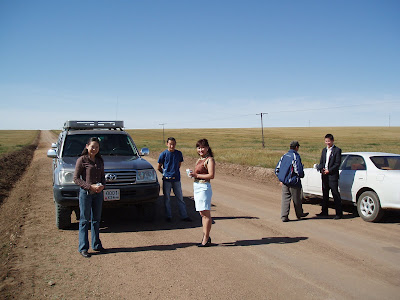Sunday, October 11, 2009
Where eagles fly
Saturday, October 10, 2009
Go West
Flying out from UB i soon fell asleep and woke up to look down on small sand dunes and a landscape of stony deserts and mountains with the city built beside a green river valley.
The work went well, tho with less experience of tourism than other aimags we had to change the workshop as we went along. The representatives of local communities wanted to be told what to do rather than develop their own ideas.
After 3 days work I travelled onto Bayan Olgi, more of that in a fture blog, before driving back to Hovd for our return flight. Unfortunately on the final night in Hovd I woke with a fever and have spent the last 5 days in bed.. Four weeks ago I felt I would live for ever after enjoying the Gobi half marathon, now I can barely walk a kilometre.
For more information on Hovd visit Gohovd website.
Wednesday, September 16, 2009
Keep on Running
On the saturday we travelled onto Dalanzadgad, our visit coincided with the annual market day and Gobi Festival organised by Mercy Corps.
The race was great: 5 entered the full marathon, 15 the half. Some had travelled from Germany, France and Macau just to enter the race; others were westerners living in Ulaanbaatar and there was one mongolian entrant, a tour guide with one of tour companies. The course was across desert tracks, mainly stones on a sandy base, then at 10 kilometres there was a 2.5 km climb up a sand dune, and at 19 kilometres a 1.5 kilometres ascent to the top of the Flamimg Cliffs, where the first dinosaur eggs were discovered in the 1920. The red sandstone cliffs the backdrop to an amazing finishing line.

team vso
Team VSO managed a respectable 3rd, 4th and 5th place.
Wednesday, September 9, 2009
Chinggis was here


Thursday, August 27, 2009
28 years
Saturday, August 22, 2009
The road less travelled
At the beginning of August I travelled east to Dornod and Hentii aimags with Tom and Amaraa. We were on a birding trip to look at lakes and river valleys; I will write an account of the birds on Birds Mongolia website.
My camera stopped working in June, so sorry I have no pictures.
Eastern Mongolia especially Dornod aimag is very different to the rest of Mongolia. The Eastern Steppe of Mongolia is the world’s largest intact temperate grassland ecosystem. At about 250,000 sq km, this vast wilderness is home to one of the world’s last great spectacles of migrating Mongolian gazelle, which may number over one million. Numerous other mammals live on the steppe, and there are many rare or critically threatened birds that nest or use the steppe for migratory stopover sites. Our focus was the lakes and river valleys which during autumn are important stops for migrant shore birds and waterfowl on their way from arctic breeding sites to wintering grounds in couth east Asia . We also hoped to see cranes, six species, that’s half of the worlds total can be seen in eastern Mongolia; we were only to see three.
For me the opportunity to travel in such a remote region was as important as any particular birds we did or did not see; camping by lakes, in the steppe and by forests, hearing wolves howling and setting off the herder’s dogs into a barking frenzy, listening to cranes and swans calling as a I lay in my tent.
Two things struck me about Darkhan, the length of grass and the low density of people. Both are related. Overgrazing is generally identified as one of the major ecological problems in Mongolia.; the number of livestock has increased from 20 million in 1990 to over 50 million. Everywhere else in Mongolia I have been I have wondered at how the animals can survive on such poor pasture. Here the grass was tall, the sward denser, a consequence of both fewer people and heavy rainfall. This summer has been exceptionally wet throughout Mongolia
Amaraa our guide and companion is just completing his masters thesis on bird deaths by power lines, a new desgn is killing large numbers of eagles on his last survey he found. Amraa is a Buriat, a distinctive ethnic group in north of Mongolia and Russia, their language is similar to Mongolian but distinct, and they live in wooden huts not gers, do not milk horses traditionally wore dels like other Mongolians but with a different fastening. Buriat make up maybe 10% of Mongolian population. Wherever we went Amraa met people he knew
I was also glad to visit VSO volunteer Raj, he and I are the only two remaining of the group of 12 who came out in February 2008. He is based in Choibalsan where he is working as a management consultant with the local health authority. . Friendships here seem short tem, westerners and volunteers are on contract a few months a year or two, so just as you get know someone they move on, to be replaced by someone else.
Thursday, July 9, 2009
Family Holiday





Sunday, July 5, 2009
Mongolian Waltz
The annual meeting was a great mix of work and fun, Mongolians love playing games and do not take themselves seriously. Here are some pictures from the meeting.












































